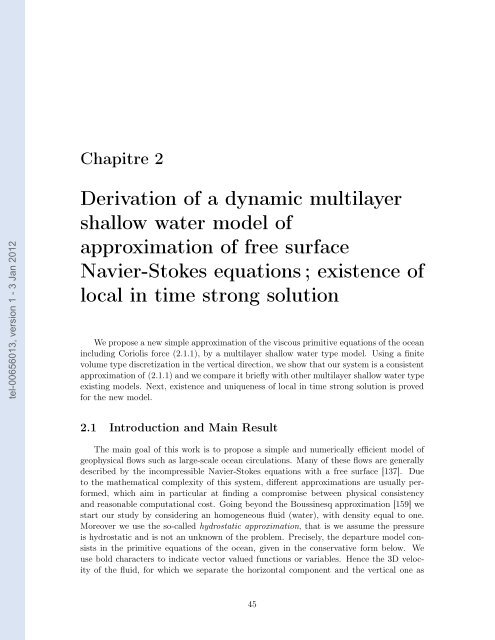Modélisation, analyse mathématique et simulations numériques de ...
Modélisation, analyse mathématique et simulations numériques de ...
Modélisation, analyse mathématique et simulations numériques de ...
Create successful ePaper yourself
Turn your PDF publications into a flip-book with our unique Google optimized e-Paper software.
tel-00656013, version 1 - 3 Jan 2012<br />
Chapitre 2<br />
Derivation of a dynamic multilayer<br />
shallow water mo<strong>de</strong>l of<br />
approximation of free surface<br />
Navier-Stokes equations ; existence of<br />
local in time strong solution<br />
We propose a new simple approximation of the viscous primitive equations of the ocean<br />
including Coriolis force (2.1.1), by a multilayer shallow water type mo<strong>de</strong>l. Using a finite<br />
volume type discr<strong>et</strong>ization in the vertical direction, we show that our system is a consistent<br />
approximation of (2.1.1) and we compare it briefly with other multilayer shallow water type<br />
existing mo<strong>de</strong>ls. Next, existence and uniqueness of local in time strong solution is proved<br />
for the new mo<strong>de</strong>l.<br />
2.1 Introduction and Main Result<br />
The main goal of this work is to propose a simple and numerically efficient mo<strong>de</strong>l of<br />
geophysical flows such as large-scale ocean circulations. Many of these flows are generally<br />
<strong>de</strong>scribed by the incompressible Navier-Stokes equations with a free surface [137]. Due<br />
to the mathematical complexity of this system, different approximations are usually performed,<br />
which aim in particular at finding a compromise b<strong>et</strong>ween physical consistency<br />
and reasonable computational cost. Going beyond the Boussinesq approximation [159] we<br />
start our study by consi<strong>de</strong>ring an homogeneous fluid (water), with <strong>de</strong>nsity equal to one.<br />
Moreover we use the so-called hydrostatic approximation, that is we assume the pressure<br />
is hydrostatic and is not an unknown of the problem. Precisely, the <strong>de</strong>parture mo<strong>de</strong>l consists<br />
in the primitive equations of the ocean, given in the conservative form below. We<br />
use bold characters to indicate vector valued functions or variables. Hence the 3D velocity<br />
of the fluid, for which we separate the horizontal component and the vertical one as<br />
45

















